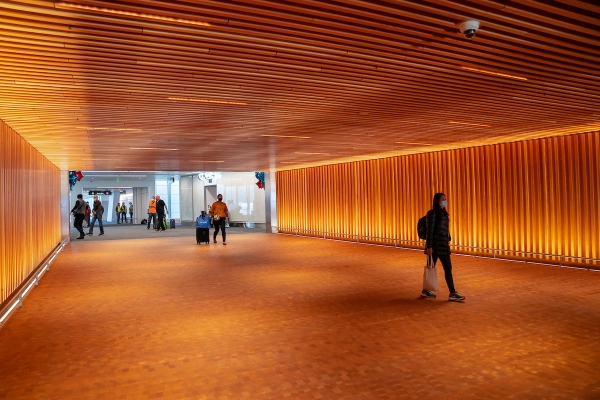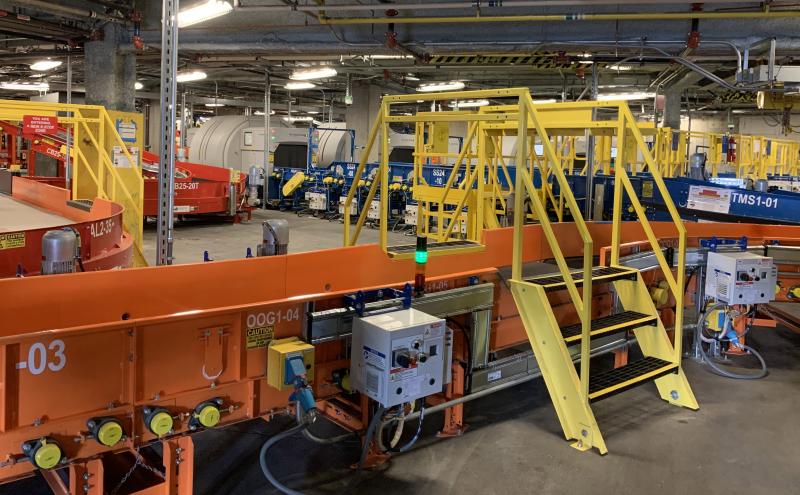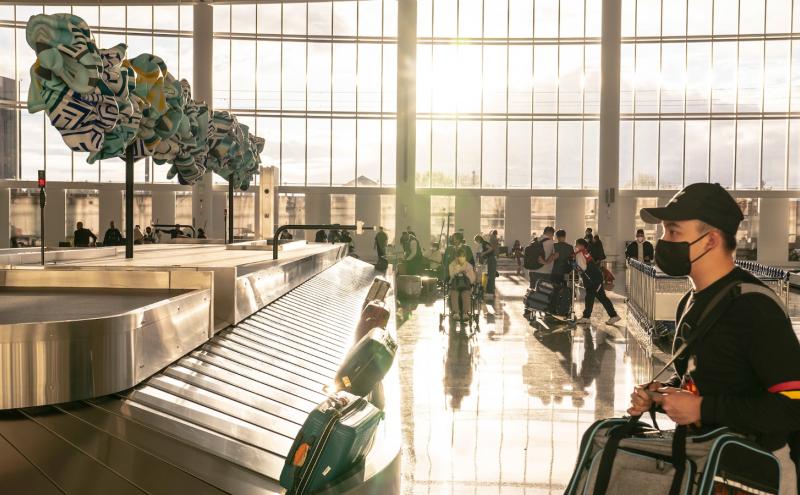
You’re a skilled navigator. You’ve mastered the winding maze of Marrakesh. Driven on the left side of narrow country roads in Ireland after an all-night flight. Or maybe even done a few laps around the Arc de Triomphe trying to get into the correct lane. And now, your foggy vacation brain faces an international arrivals entrance at Seattle-Tacoma International Airport (SEA) to the brand new International Arrivals Facility (IAF). You got this. The streamlined process won’t threaten your vacation zen just yet. (Until you read your first work email).
The good news is that your arrival experience will be significantly better. With the opening of the new IAF, SEA Airport has just completed the most complex capital development program in its 71 year history that will significantly improve the arrival process for international passengers without adding new gates.
And the United States Customs and Border Protection (CBP) is rolling out Bags First, a new arrivals process and technology.
The bad news is that we can’t help solve your jetlag (you know we would if we could!). But with the more efficient entry process you’re closer to your "I-know-I-shouldn't-but-I-just-can't-stay-awake" post-landing snooze than ever before.
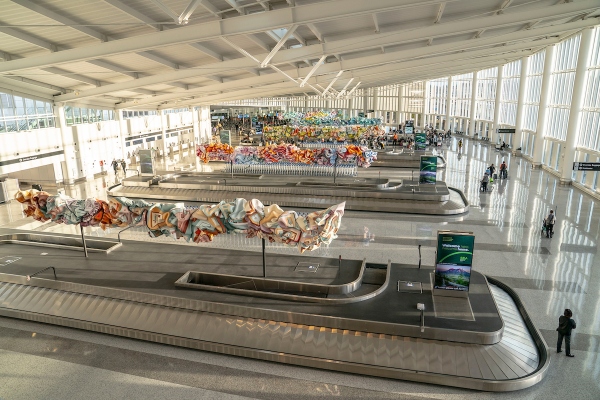
Here's an insider view of the Bags First international arrival process.
What is Bags First?
It’s a concept from the United States Customs and Border Protection that is in place in a few smaller U.S. airports. The big news is that SEA will be the first large hub airport in the United States to roll out this streamlined entrance process.
The big differences from the past process are that you collect your bags first and only once, complete less paperwork, and speak to one agent during the process. The big news is that a few of the frustrating steps from the past process have been eliminated. Here's the net net:
- If SEA is your final destination, you no longer have to pick up your bags in customs, recheck them, then take the train to reclaim your bags in the main terminal
- In the new process, you pick up your bags first and only once and exit directly to the main terminal
Process flow
Here’s an overview of the new flow (as compared to the old).
Travelers with the final destination of SEA
Here’s how it goes for travelers whose final destination is the lovely Pacific Northwest:
| New Process | Old Process |
|---|---|
| 1. Landing and arrival | 1. Landing and arrival |
| 2. Use the restroom or proceed directly to baggage claim | 2. CBP Passport control:
|
| 3. Collect your bag in the Grand Hall | 3. Wait at baggage claim to pick up your bag |
|
4. Proceed through U.S. Customs and Border Protection using facial recognition
|
4. Wait in line to talk to Customs Officer
|
|
5. Roll down the walkway into Gina Marie Lindsey Arrivals Hall and head out
|
5. Put your luggage back on the conveyor belt |
| 6. Take the train to baggage claim | |
| 7. Wait at baggage claim for your luggage to arrive again | |
| 8. Head out of the airport |
Travelers with connections
And here’s how it goes for travelers who are connecting to other flights through SEA. The difference in paths depends upon whether the Transportation Security Administration (TSA) checkpoint is staffed in the IAF.
TSA open hours are 8:00 a.m. to 10:00 p.m.
| When TSA is open (8:00 a.m to 10:00 p.m.) | When TSA is closed |
|---|---|
| 1. Landing and arrival | 1. Landing and arrival |
| 2. Use the restroom or proceed directly to baggage claim | 2. Use the restroom or proceed directly to baggage claim |
| 3. Collect your bag in the IAF Grand Hall | 3. Collect your bag in the IAF Grand Hall |
|
4. Proceed through U.S. Customs and Border Protection using facial recognition
|
4. Proceed through U.S. Customs and Border Protection using facial recognition
|
| 5. Stay to the right and watch for staff who will help you recheck your bags; put your bags on the conveyor belt |
5. Walk down the ramp out of the IAF
|
|
6. Proceed through TSA security checkpoints inside the IAF Enter the main terminal near Gate A6 by the Capitol Hill Food Court |
6. Exit into Gina Marie Lindsey Arrivals Hall |
| 7. Connect to your next flight | 7. Check your bags in at your airline ticket counter in the main terminal |
| 8. Go through any TSA Security checkpoint in the main terminal and head to your gate |
What’s different?
More room to roam and an efficient process
The IAF is a new multi-level, 450,000-square-foot facility located east of the current A Concourse. An iconic aerial walkway, which spans 780 feet across and 85 feet above the existing taxi lane, connects arriving international passengers from the S Concourse across the top of A Concourse to the new IAF.
What does that mean to your journey?
- Nearly twice as many gates can accommodate international flights (from 12 to 20)
- More space, including the Grand Hall, that handles more than twice the passenger capacity, up to 2,600 passengers per hour (compared to 1,200)
- Enhanced technologies so you will get through passport check in less time
- A goal to reduce minimum passenger connection time from 90 to 75 minutes
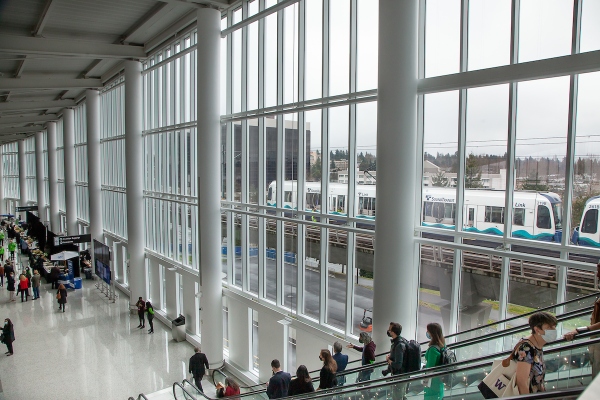
Enhanced signage
The new facility takes customer service to a new level, with clear digital signage that tells you the steps in your international entrance and what's coming next. You will get helpful information like:
- A process diagram that shows the next steps in your arrival on both digital and static wall signs
- Walking times to baggage claim that are dynamically updated depending upon where you are in the process
- Scrolling instruction translated into the top eight most common languages spoken according to the airport’s language line
- Instructional video clips that tell you how to prepare and what to do in the next step of your journey
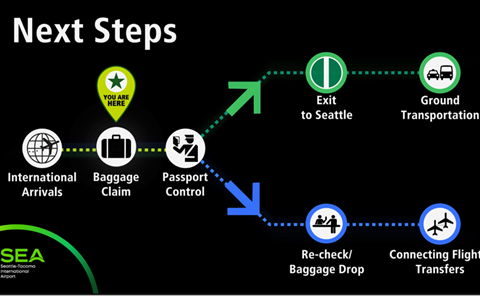
Screening technology
Under its federal authority, U.S. Customs and Border Protection (CBP) already uses biometric technology to confirm the identity of passengers leaving the country at more than two dozen U.S. airports, including SEA.
Facial recognition technology can speed your entrance. Note that you no longer have to complete the blue customs declaration form or stand in front of a kiosk and have your photo taken because of this technology. These changes may save a few seconds per person; but added together for an entire aircraft or series of arrivals, it means a big difference for everyone!
"With Biometric Facial Comparison, we’re simply comparing traveler photos against their existing passport or visa photo. It’s our existing process, only now more secure and efficient."
— CBP Deputy Executive Assistant Commissioner John Wagner
According to the CBP, this is how biometrics works:
- During boarding or arrival, a traveler's photo is taken where you would normally present your passport for inspection
- The photo is compared against an existing passport or visa photo
- A CBP officer interviews the traveler to validate results, establish the purpose and intent of travel, and determine admissibility
- All traveler photos of U.S. citizens are deleted and no photos are ever shared with industry partners
A Customs and Border Protection report outlines how the arrival process works (hint: less paper):
Once a traveler has collected his or her baggage and reaches CBP primary, CBP will the capture the same facial biometric to reconnect with the APIS information and facial biometric collected predeparture through the Document Validation process. This process confirms identity and retrieves associated passport, visa, and other relevant information — removing the need for CBP to handle travel documents and other paper. The use of biometric technology in the CBP arrivals area is key to modernizing air passenger processing and meets multiple objectives of OFO’s Innovation Strategy. Biometrics enhance OFO’s security posture; facilitate going paperless; and advance automated processing, progressing from a kiosk-based process and opening up facility space. In addition, biometric confirmation at entry also may be used to confirm exit with integrated biometric technologies on outbound. This plan does acknowledge, however, that there may continue to be a need for limited traditional processing in situations where biometric entry is not possible; accordingly, facilities will incorporate a limited number of CBPO and CBPAS stations in both primary and secondary, equipped for the traditional process.
— Source: CBP report
Note: If you choose not to participate in biometric screening, there is an alternative process at SEA. Notify an officer when you arrive that you choose not to participate in biometric screening.
The Port is working with CBP to ensure that passengers are fully educated about their rights and options related to facial recognition screening.
- Learn more about biometric facial comparison, the process, and your privacy from the U.S. Customs and Border Patrol
- Learn about Port of Seattle policies on biometric screening at SEA Airport
- Read FAQs from the Port of Seattle about facial recognition technology
- Read Commissioner Cho’s blog about biometrics and protecting passenger privacy
Bathrooms!!!
No more waiting in a long passport line before using the restrooms. There are nearly three times as many fixtures in the new facility and they are available shortly after you get off the plane.
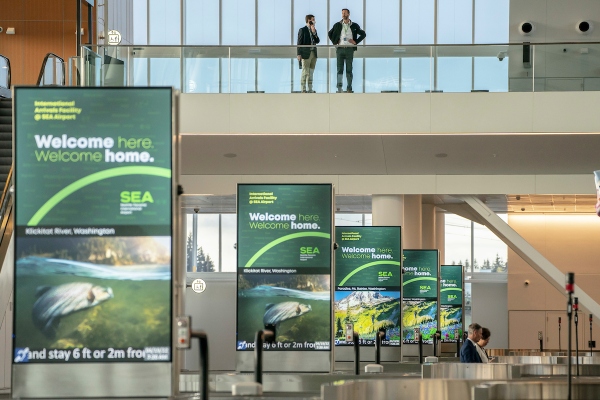
Accessible entry
The new system and facility are more accommodating and accessible for people with disabilities.
If you notified your airline in advance that you need assistance, CBP knows you are coming and will keep an eye out to help. Watch signs for guidance, and CBP officers can assist and answer your questions. Get more information about accessible travel from the SEA Customer Service team or look for the Pathfinders in the bright green jackets for help.
• Learn more about accessibility at SEA
Better baggage process and capacity
This new facility is a major upgrade in both form and function. The baggage claim devices have nearly tripled in size, from four devices with 668 linear feet in the current space to seven devices and 1,806 linear feet! In addition, the size and number of bag claim carousels have increased from four to seven.
The oversize baggage process will also be quicker and more convenient. There is now a dedicated oversize baggage belt that is less curvy and deposits oversize bags directly into the baggage claim area, across from carousels 20 and 21 with no stops in between. The larger belt, which is five feet wide, can accommodate skis, golf clubs, and lots of your vacation gear. For larger items like paddleboards, they will be brought up on a dedicated service elevator and delivered next to the oversize baggage belt.
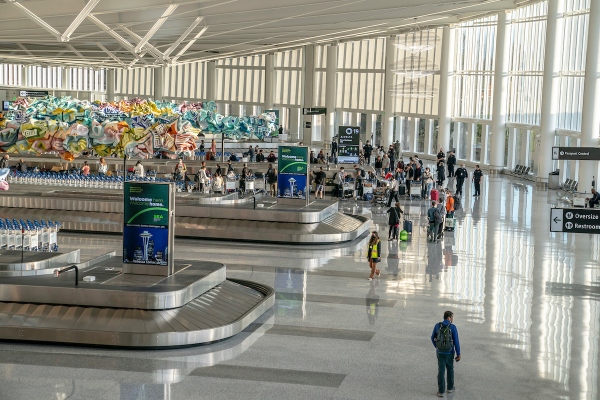
Flexibility for peak times
The new CBP facility has enough room and the ability to adjust CBP staffing levels to serve the projected loads for international arrivals, both peak and less busy times. Note that you won’t see all agent booths full if you are not arriving at the peak times. Rest assured, the extra capacity will make your entrance as efficient as possible.
Quick tips for arriving passengers
1. Get your bags first
Pick up your bags as soon as you arrive. That’s really the thing to know.
2. Eyes on the signs
Keep your eyes open for signage and wayfinding information that will help you through the process including:
- Visible reminders like “get your bags” reminders on signs and process maps
- “You are here” markers that tell you where you are and what’s ahead
- A welcome portal of three screens that instruct you where to pick up your bags
3. Listen up
- There will be audible announcements (25 different announcements in fact) to remind you to pick up your bags
- If in doubt, ask a SEA customer service agent, Pathfinder in green, or CBP officer stationed along the way to help
And that’s all you need to know about international arrivals. With the launch of this new facility, SEA Airport welcomes you to the region and the future of international travel.
Welcome here. Welcome home.
